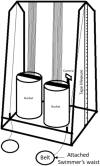Seasonal changes in physiological and psychological parameters of stress in collegiate swimmers
- PMID: 37419893
- PMCID: PMC10328912
- DOI: 10.1038/s41598-023-37124-x
Seasonal changes in physiological and psychological parameters of stress in collegiate swimmers
Abstract
To investigate the seasonal changes in physiological and psychological parameters of stress in collegiate swimmers. Fifteen NCAA Division I swimmers (8 men) participated in a tethered anaerobic swim test to determine physiological responses in an ecologically-relevant, graded exercise test. Wisconsin Upper Respiratory Symptom Survey (WURSS-21), Activation-Deactivation Adjective Check List (AD-ACL), Daily Analysis of Life Demands of Athletes (DALDA), and Pittsburgh Sleep Quality Index were assessed at post-season in April (V1), the end of off-season in June (V2), and pre-season in October (V3). The percent change was determined from V2-V1 (off-season phase), V3-V2 (pre-season phase), V1-V3 (in-season phase). Spearman's rho correlation was used to examine associations between change in physiological and psychological outcomes. All data results showed a better swim performance occurred at V2. Men tended to have faster speed (p = 0.07) in fewer strokes (p = 0.10) and greater work per stroke (p = 0.10) at V2 than V1. Women were faster during V2 compared to V1 (p = 0.02) and V3 (p = 0.05). Women had fewer strokes (p = 0.02) and greater work per stroke (p = 0.01) at V2 compared to V3. Women had the lowest HR and lactate concentration at V3 compared to other visits (p < 0.05). During the in-season phase, swim speed decreased the greatest extent and stress sources and symptoms assessed by DALDA had greatest elevation (p < 0.05). An increased in stress sources and symptoms assessed by DALDA was associated with an increase in upper respiratory illness from WURSS-21 (rho = 0.44, p = 0.009), being less energetic (rho = - 0.35, p = 0.04) and greater tension state (rho = 0.49, p = 0.003; AD-ACL), and a decrease in swim speed (rho =- 0.38, p = 0.03). Swim performance peaked at off-season when psychological stress was at its lowest. The relationship between DALDA scores with psychological parameters and swim performance suggested physiological and psychological parameters of stress is an important aspect to avoid overtraining when approaching high swim performance.
© 2023. The Author(s).
Conflict of interest statement
The authors declare no competing interests.
Figures




References
-
- Stults-Kolehmainen MA, et al. Higher chronic psychological stress is associated with blunted affective responses to strenuous resistance exercise: RPE, pleasure, pain. Psychol. Sport Exerc. 2016;22:27–36. doi: 10.1016/j.psychsport.2015.05.004. - DOI
Publication types
MeSH terms
LinkOut - more resources
Full Text Sources
Miscellaneous

